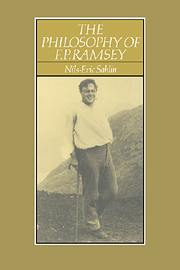Book contents
- Frontmatter
- Contents
- Preface
- Acknowledgements
- INTRODUCTION
- Chapter 1 PHILOSOPHY OF PROBABILITY
- Chapter 2 BELIEF AND TRUTH
- Chapter 3 KNOWLEDGE
- Chapter 4 GENERAL PROPOSITIONS AND CAUSALITY
- Chapter 5 PHILOSOPHY OF SCIENCE
- Chapter 6 LOGIC AND MATHEMATICS
- Chapter 7 RAMSEY'S THEOREM
- Chapter 8 UNIVERSALS
- Chapter 9 ECONOMICS
- Chapter 10 BIOGRAPHICAL GLIMPSES
- Notes
- Bibliography of F. P. Ramsey's works
- Index of names
Chapter 1 - PHILOSOPHY OF PROBABILITY
Published online by Cambridge University Press: 18 September 2009
- Frontmatter
- Contents
- Preface
- Acknowledgements
- INTRODUCTION
- Chapter 1 PHILOSOPHY OF PROBABILITY
- Chapter 2 BELIEF AND TRUTH
- Chapter 3 KNOWLEDGE
- Chapter 4 GENERAL PROPOSITIONS AND CAUSALITY
- Chapter 5 PHILOSOPHY OF SCIENCE
- Chapter 6 LOGIC AND MATHEMATICS
- Chapter 7 RAMSEY'S THEOREM
- Chapter 8 UNIVERSALS
- Chapter 9 ECONOMICS
- Chapter 10 BIOGRAPHICAL GLIMPSES
- Notes
- Bibliography of F. P. Ramsey's works
- Index of names
Summary
Many earlier theories of probability focused upon concepts intimately connected with the possible outcomes of parlour games: e.g., what is the probability that the King and Queen of Spades will come up if five cards are drawn from a pack? Even today such questions can spark off heated arguments and feelings among card-players. But besides these trivialities, there were, broadly speaking, two main theories of probability discussed at Cambridge when Ramsey wrote his masterpiece ‘Truth and Probability’ in 1926: frequency theories and logical theories.
Underlying frequency theories is the idea that the probability of an event is linked to the observed frequency of occurrences of this event. When a surgeon tells a patient that the probability of his recovery is .95, he means that this is the proportion of patients who have actually recovered from this operation. This is not to say that the patient can infer that the probability that he himself will recover is .95. Strictly speaking, the doctor has only stated the probability that a patient, randomly selected from those already operated on, would be one who had recovered. Probability theory is thus rooted in actual percentages; no subjective element is admitted.
Examples of this sort of reasoning may be found as early as the mid-sixteenth century in Cardano's works: but it was a hundred years before probability theory assumed a stricter logical form that made possible more precise discussions of the subject.
- Type
- Chapter
- Information
- The Philosophy of F. P. Ramsey , pp. 11 - 54Publisher: Cambridge University PressPrint publication year: 1990

